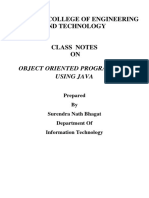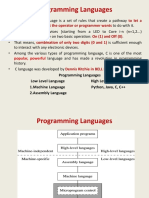0% found this document useful (0 votes)
32 views2 pagesLevels of Code
The document outlines the hierarchy of programming languages, starting from machine code, which is binary and hardware-dependent, to low-level code like assembly language that is more readable but still close to hardware. It then describes high-level languages, such as Python and Java, which are human-readable and portable across platforms. Each category has its pros and cons, with low-level languages offering fast execution and high-level languages providing ease of use and maintenance.
Uploaded by
vidhikapoor1298Copyright
© © All Rights Reserved
We take content rights seriously. If you suspect this is your content, claim it here.
Available Formats
Download as PDF, TXT or read online on Scribd
0% found this document useful (0 votes)
32 views2 pagesLevels of Code
The document outlines the hierarchy of programming languages, starting from machine code, which is binary and hardware-dependent, to low-level code like assembly language that is more readable but still close to hardware. It then describes high-level languages, such as Python and Java, which are human-readable and portable across platforms. Each category has its pros and cons, with low-level languages offering fast execution and high-level languages providing ease of use and maintenance.
Uploaded by
vidhikapoor1298Copyright
© © All Rights Reserved
We take content rights seriously. If you suspect this is your content, claim it here.
Available Formats
Download as PDF, TXT or read online on Scribd
/ 2


























































